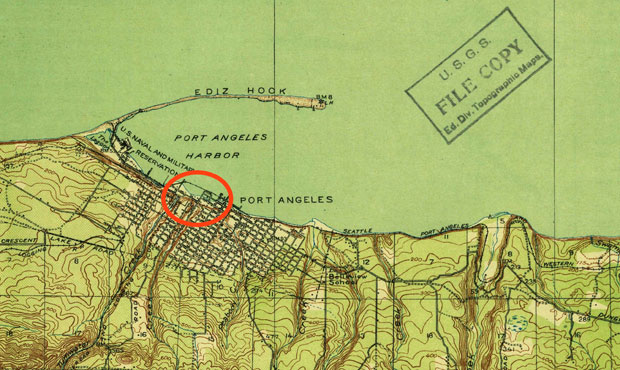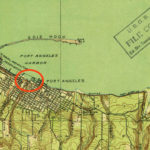All Over The Map: A deadly forgotten flood leveled Port Angeles in 1863
Dec 20, 2019, 10:00 AM
A government survey in the 1850s of potential railroad routes described what’s now Port Angeles as “the first attempt of nature on this coast to form a good harbor.”
Port Angeles is the county seat of Clallam County, and is on the Olympic Peninsula, along the Strait of Juan de Fuca.
Captain Juan Francisco de Eliza of Spain called the natural harbor formed by Ediz Hook “Porto de los Nuestra Señora de los Ángeles” in 1791. This translates in English as “Port of Our Lady of the Angels,” or another name for Mary, mother of Jesus. In 1792, Galliano and Valdes of Spain shortened the name to “Porto de los Angeles.” Then, in that same year, Captain Vancouver of England shortened and anglicized it to Port Angeles. The name stuck.
American settlement began in earnest around 1861, when the community was called Cherburg (which some sources spell as “Cherbourg”). Growth of the economy and the population was boosted by the re-location of the U.S. Customs House in 1862, which was a plumb that had been wrested away from its previous location in nearby Port Townsend. With the Customs House, Port Angeles became the official “port of entry,” and every ship entering American waters had to stop there.
The man who secured this bureaucratic windfall for Port Angeles was Victor Smith from Cincinnati. Smith was active in politics, and had been appointed Collector of U.S. Customs for the Puget Sound District by President Lincoln.
Smith developed a grand vision of Port Angeles as “The Second National City of the U.S.”—a sort of “junior version” of Washington, D.C. — and as a place to perhaps profit from by speculating in boomtown real estate.
In those early years of Port Angeles, the settlement created by Victor Smith was on the far west end of what’s now downtown. Businesses and homes, and the Customs House, were clustered around Valley Creek. The creek, with its supply of fresh water, flowed down from the hills south of town, through a narrow canyon or gorge, and out into the harbor.
In spite of everything Victor Smith accomplished, things took a deadly turn for the young settlement on Wednesday, December 16, 1863.
It was an unusual sound that people noticed first, sometime around 6 in the evening. It was theorized later that somewhere up in those hills, Valley Creek had become blocked by trees and other debris, and maybe snow and ice, and a lake had formed behind the blockage.
Then, something shifted suddenly and all that pent up water and debris let loose. A 15-foot wall of water and mud — likely filled with logs and boulders, too — rushed down Valley Creek and right through the heart of Port Angeles.
Victor Smith was out of town, but his wife was home in the residence portion of the Customs House. Somehow, Mrs. Smith rescued her four young children, as well as Mrs. Randolph, an African-American woman who worked for the family as a domestic.
Two Customs House employees weren’t as lucky.
“Crushed like an egg shell, the custom-house fell and was carried out to the harbor,” wrote 19th century historian Hubert Howe Bancroft (or one of his many ghostwriters). “Deputy [Customs] Collector of J.M. [or, according to some sources J.W.) Anderson, formerly of Ohio, and William B. Goodell, lately master of the tug General Harney, stood at the front entrance of the building as the water, and debris it carried, struck the rear side. Their bodies were found [the next morning] 200 feet away, covered four feet deep with her than fragments of buildings and furniture.”
In addition to the Customs House and several residences, many other structures were destroyed, including the Marine Hospital; the Rough and Ready Saloon; a combined butcher shop and residence; and 200 feet of the wharf lining the harbor. A home belonging to the Stanton family ended up floating in the harbor.
According to a memoir written by Goodell’s sister Phoebe Goodell Judson, the damage was spread over an area 100 yards wide and a mile long. Judson also wrote that natives had apparently warned Victor Smith about the flood danger at the Valley Creek site, but the warning wasn’t heeded.
In the wake of the disaster, the town, which had a population of perhaps a few hundred before the flood, dwindled to a dozen or so by 1864. Town founder Victor Smith died in a shipwreck in 1865, and the Customs House was then returned that same year to Port Townsend.
Smith’s dream and Port Angeles itself faded away for the next 25 years. In the 1880s, Bancroft wrote that the town was “reduced to the condition of a small farming community.”
It wasn’t until 1887 that Port Angeles began to grow again, when the Puget Sound Cooperative Colony, a utopian community, settled on the east end of town, on the opposite side of where the flood had hit 24 years earlier. Like many similar utopian communities in the Pacific Northwest, it only lasted a few years, though it did contribute to Port Angeles’ rebirth.
Inspecting Valley Street on foot from the waterfront into the hills in 2019, a visitor would never know there had been a flood. There’s no obvious signs of damage, and no monument or marker commemorating those who died.
Kathryn Estes of the of the North Olympic History Center theorizes that in the late 19th century, boosters weren’t keen on mentioning the disaster for fear of scaring away potential investors or residents.
The North Olympic History Center has a fair amount of documentation of what they call the “Flood of 1863,” and at least one artifact: An old dictionary that was washed away from one of the buildings, perhaps the Customs House, and retrieved from the wreckage.
Evidence of Victor Smith’s legacy is a little harder to find, though his son became one of the biggest boosters of the second version of Port Angeles in the 1890s, and served as mayor for a time.
At least one source says that Smith’s layout – and even some of the names of the streets – mimics his hometown of Cincinnati, Ohio, with the harbor taking the place of the Ohio River.
Sure enough, comparing a map of the Ohio city from the 1860s with a current map of Port Angeles, at least three streets in the Olympic Peninsula town mimic Cincinnati in name and placement: Vine, Race, and Front.

















